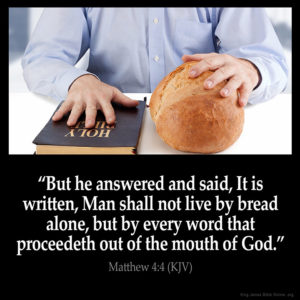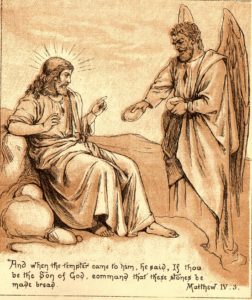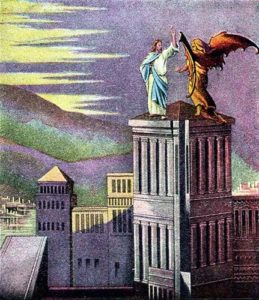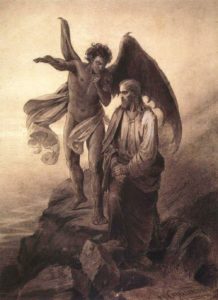Sep
1
Christ’s Temptations: Did Matthew or Luke Get the Order Wrong?
Having parallel accounts within the Bible for some events and incidents is great for biblical study purposes and for apologetics. The Synoptic Gospels (i.e., Matthew, Mark, Luke) are notable for this. But, they can also be a double-edged sword, so to speak, when certain details seem to be inconsistent between accounts.
 A few weeks ago, I took note of the comments made on Facebook by someone — I’ll call him “TR” — struggling with an apparent contradiction in the Gospels. The texts in question were Matthew 4:1-11 and Luke 4:1-13, which are parallel accounts describing the temptations Satan presented to Jesus at the end of His 40 days of fasting in the wilderness. As TR put it,
A few weeks ago, I took note of the comments made on Facebook by someone — I’ll call him “TR” — struggling with an apparent contradiction in the Gospels. The texts in question were Matthew 4:1-11 and Luke 4:1-13, which are parallel accounts describing the temptations Satan presented to Jesus at the end of His 40 days of fasting in the wilderness. As TR put it,
“The sequences of events are out of order, and what the devil says in Luke 4:6,7 doesn’t match what he says in Matthew 4:9.”
Here’s how he laid it out to show the differences (using the KJV, apparently):
“Matthew 4:9 (Satan speaking):
“All these things will I give thee, if thou wilt fall down and worship me.”
Luke 4:6,7 (Satan speaking):
“All this power will I give thee, and the glory of them: for that is delivered unto me; and to whomsoever I will I give it. If thou therefore wilt worship me, all shall be thine.
Matthew’s sequence (Satan speaking):
1. “If thou be the Son of God, command that these stones (plural) be made bread.”
2. “If thou be the Son of God, cast thyself down [from the pinnacle of the temple].”
3. “All these things [all the kingdoms of the world seen from the mountaintop] will I give thee, if thou wilt fall down and worship me.”
Luke’s sequence (Satan speaking):
1. “If thou be the Son of God, command this stone (singular) that it be made bread.”
2. “All this power [all the kingdoms of the world seen from the mountaintop] will I give thee, and the glory of them: for that is delivered unto me; and to whomsoever I will I give it. If thou therefore wilt worship me, all shall be thine.”
3. “If thou be the Son of God, cast thyself down from hence [from the pinnacle of the temple].””
 While he recognized that there are often ways of explaining such inconsistencies and still maintaining biblical integrity, TR was somewhat stumped and chalked this one up to being an actual contradiction, one in which the “authors’ sources (or the sources of the sources) are mistaken.” Further, he speculated that each evangelist had a different, “fallible angel” as a witness.
While he recognized that there are often ways of explaining such inconsistencies and still maintaining biblical integrity, TR was somewhat stumped and chalked this one up to being an actual contradiction, one in which the “authors’ sources (or the sources of the sources) are mistaken.” Further, he speculated that each evangelist had a different, “fallible angel” as a witness.
“One or the other got the order wrong. One either unintentionally or deliberately abbreviated what Satan said, and the other tried to give a complete account. There was no malicious intent to distort the truth. Like modern witnesses to a crime, they were simply passing on, to the best of their ability, what they recalled….
[W]e have to wonder why the Holy Spirit would have had Matthew record that the temptation on the pinnacle of the temple happened before the temptation on the mountain top, and why the Holy Spirit had Luke record that the temptation on the mountaintop happened first. Didn’t the Holy Spirit know which happened first?…”
After more discussion about court cases and the fact that witnesses can’t be expected to provide identical accounts in every detail — indeed, it is suspicious when they do — TR concludes:
“So I don’t believe the exact wording in the Gospel accounts is word-for-word what the Holy Spirit told them to say, as if the authors were secretaries taking dictation, or a stenographer in a courtroom. The Holy Spirit can be expected to guide and to remove obstacles to memory, but not inject fake memories (especially imperfect fake memories) into the minds of chosen witnesses. That would be dishonest, and the Holy Spirit is never dishonest.”
I can agree with some of what TR says, but some of his premises and conclusions don’t sit right with me. (For one thing, he seems to take a looser view of the inspiration and infallibility(?) of Scripture than I do.) Put another way, I think he is partly right, but his description and characterization of the issue is misleading.
 As is often the case, the problem seems to arise from the common modern assumption that writers in biblical times put the same emphasis that we 21st-century Westerners do on chronology and presentation of other details. They didn’t. Another factor is that some people forget (or never realized) that each gospel-writer had his own style, purpose, and primary audience in mind when he wrote, all of which affected his choices of what to write about, what to emphasize, how to say it, etc. So, for example, Matthew’s audience was the Palestinian Jews, so he emphasizes Jesus’s Kingship and Messiahship, as He fulfills the promises & predictions of the Hebrew Scriptures. Luke, on the other hand, was generally more concerned with presenting an historically accurate biography of Jesus as the perfect “Son of Man”.
As is often the case, the problem seems to arise from the common modern assumption that writers in biblical times put the same emphasis that we 21st-century Westerners do on chronology and presentation of other details. They didn’t. Another factor is that some people forget (or never realized) that each gospel-writer had his own style, purpose, and primary audience in mind when he wrote, all of which affected his choices of what to write about, what to emphasize, how to say it, etc. So, for example, Matthew’s audience was the Palestinian Jews, so he emphasizes Jesus’s Kingship and Messiahship, as He fulfills the promises & predictions of the Hebrew Scriptures. Luke, on the other hand, was generally more concerned with presenting an historically accurate biography of Jesus as the perfect “Son of Man”.
In this particular case, we need to look closely at a few key words — specifically, the adverbs and conjunctions which connect the temptations in each account. Luke uses <kai> (“and”) to introduce his second temptation and <de> (“and” or “but”) to introduce his third. Matthew, on the other hand, uses <tote> (“then”) to introduce his second temptation and <palin> (“again”) to introduce his third. Those used by Matthew are much more emphatic in regard to sequence.
It is therefore much more likely that Matthew retained the chronology of the events, whereas Luke had something else, something more topical, in mind. But, isn’t Luke the Synoptist who put the most emphasis on presenting events in chronological order? What was he up to, here?
The late Gleason Archer, esteemed professor emeritus of Old Testament and Semitic languages, suggested that it was for dramatic effect. He explains:
“This is very clearly brought out by the ensuing episode: Jesus’ visit to His hometown of Nazareth. It was a very striking development that right after He had passed through the gauntlet of spiritual battle with Satan (vv.1-13), and thus proved His mettle as Messiah, Jesus should have made His way first of all back to His own people in Nazareth. But there He met with incredulity and rejection and even had His life threatened before He finally departed for Capernaum.
Very significantly in the course of His sermon at the Nazareth synagogue, Jesus quoted the people as murmuring against Him, ‘Physician, heal yourself! Those great things that we heard took place in Capernaum, perform them here as well, in our own hometown!’ (v.23) But the interesting thing about this remark is that up until this point Luke had made no mention of Capernaum at all, and yet Jesus’ audience had already heard about the miracles He had performed there. Not until after He escaped from the riot His sermon evoked does our Lord make His way back to Capernaum, which He had begun to use as His headquarters. His reception there was far more cordial and appreciative than at Nazareth (4:31-32), and it was there that He performed the notable miracles of healing the demoniac in their synagogue (vv.33-37) and instantaneously curing Peter’s mother-in-law as she lay at death’s door with a high fever (vv.38-39). It may have been that these particular cures were performed after His visit to Nazareth; but there can be no doubt (on the basis of v.23) that Jesus had already been to Capernaum and had done some notable miracles there before He went over to Nazareth (cf. vv.14-15). Yet Luke does not mention Capernaum by name until after Nazareth. The advantage he gained from the heightened contrast between the two cities may have prompted him in this case also to depart from strict chronological sequence.”
So, Matthew retained the sequence of events, while Luke seems to have had valid reasons for presenting the narrative in a different order. There is no need to conclude that the Holy Spirit was confused or that Luke got bad info or anything like that. As is evident from studying the rest of the Gospels and other ancient documents, the ordering of events was less important to contemporary authors and their audiences than the message being conveyed. This was not an <actual> contradiction but merely an odd, yet resolvable, inconsistency.
As far as Matthew giving Satan fewer words to say (4:9) than Luke does (4:6,7), that isn’t such a big deal, either. Another common device used back then was the telescoping (and sometimes summarizing) of speeches and events, and it was entirely legit. As TR suggested, “[Matthew] deliberately abbreviated what Satan said, and [Luke] tried to give a complete account. There was no malicious intent to distort the truth.” Nor must we conclude that one of them “got it wrong”.
 That leaves us with the “stone” (singular) that Luke refers to in the first temptation vs. the “stones” (plural) that Matthew records. I found nothing about this in my usual sources, and I verified that the Greek agrees with this translation. I admit, this one has me stumped. It might be that the total discussion between Jesus and Satan was longer and included statements with both the singular and plural. Matthew and Luke then each chose one or the other for their respective accounts, giving the essence of the conversation. I have no problem with this, or there may be another plausible explanation. Either way, it is a small, irksome inconsistency, but it doesn’t rise to the level of definite contradiction or something that puts the Bible’s trustworthiness at risk. Certainly, no doctrine is affected, so I’m not gonna sweat it.
That leaves us with the “stone” (singular) that Luke refers to in the first temptation vs. the “stones” (plural) that Matthew records. I found nothing about this in my usual sources, and I verified that the Greek agrees with this translation. I admit, this one has me stumped. It might be that the total discussion between Jesus and Satan was longer and included statements with both the singular and plural. Matthew and Luke then each chose one or the other for their respective accounts, giving the essence of the conversation. I have no problem with this, or there may be another plausible explanation. Either way, it is a small, irksome inconsistency, but it doesn’t rise to the level of definite contradiction or something that puts the Bible’s trustworthiness at risk. Certainly, no doctrine is affected, so I’m not gonna sweat it.
















